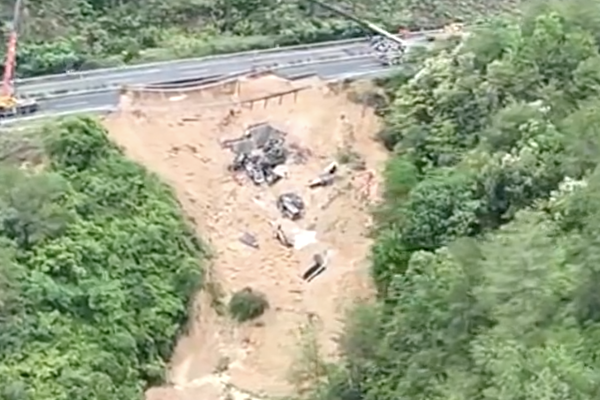On May 1st, in the early morning, a sudden road collapse occurred in the Cha Yang section of the Meidagao Expressway in Guangdong, China. The official report of the number of deaths and the amount of cars trapped under the collapse surged the next day, sparking questions. Online articles questioned how many cars were actually buried in the Meidagao Expressway collapse and why they had to be excavated to find out. Chinese Communist Party leader Xi Jinping only instructed the rescue operations the following day, emphasizing stability, which also sparked criticism.
May 3rd, on the WeChat public account “Constructive Opinions,” an article titled “How Many Cars Were Buried in the Meidagao Expressway Collapse? Do We Need to Dig Them Out to Know?” raised doubts about the varying reports on the number of cars trapped in the collapse incident. The article pointed out that as the rescue missions progressed, the number of casualties increased gradually, which was understandable since people inside the vehicles needed to be rescued to determine their status. However, the constantly changing number of trapped cars raised suspicions and should not have happened.
The article analyzed that the accident occurred on a highway, a relatively closed-off area where the number of vehicles entering and exiting the monitored checkpoints at both ends of the accident site could be accurately counted, even down to the license plates. With advanced technology and precise data collection systems in place, it should have been relatively easy for the transportation authorities to obtain accurate information about the vehicles that entered the area on the evening of April 30th and did not exit by noon on May 1st. Therefore, having precise vehicle data should have been readily available to guide the rescue efforts immediately.
Questioning why there was a need to manually count and dig out the cars during the rescue, the article emphasized the importance of having accurate vehicle data in real-time to aid rescue teams. By comparing the number of vehicles excavated with the number of missing vehicles, rescuers could determine if there were still trapped vehicles and individuals under the debris, ensuring the rescue operations were thorough and efficient.
In recent years, governments worldwide have invested heavily in purchasing and implementing smart city systems to precisely monitor traffic data, with one of the goals being to enhance road safety and efficiency. In China, highways are equipped with numerous cameras that can detect speeding violations and other infractions. Therefore, it is questioned why, with such advanced technology and surveillance capabilities, the authorities could not have promptly provided accurate vehicle data to assist in the rescue efforts.
The article raised concerns over whether relevant authorities deliberately chose not to maintain precise information on the number of vehicles buried in the Meidagao Expressway collapse or simply failed to do so. It questioned the necessity for prioritizing social stability over accurate and timely rescue operations, especially when people’s lives are at stake.
On May 2nd, the Chinese state media Xinhua reported that Xi Jinping had issued “important instructions,” emphasizing the need to ensure “overall social stability,” one day after the accident occurred.
An American senior bridge structural design engineer, Zhuxue Ye, highlighted that Xi Jinping’s emphasis on stability was in line with the typical Communist Party policy of prioritizing social stability over the exact number of casualties. This approach aimed to prevent unrest among the families of the deceased. Zhuxue Ye cited the example of the Zhengzhou flood in July 2021 where the official death toll was disputed, indicating a pattern of underreporting casualties to maintain stability.
Regarding the collapse on the Meidagao Expressway, Zhuxue Ye emphasized that incidents like these are not natural disasters but rather consequences of poor construction quality. He attributed such incidents to corruption within the Communist Party, where the focus on economic growth led to hasty and compromised infrastructure projects. Zhuxue Ye warned that as these issues become more apparent over time, similar accidents would likely increase in frequency.
The handling of the Meidagao Expressway collapse has led to further scrutiny of the Chinese government’s priorities and responses to such disasters. The questions raised regarding transparency, accountability, and the prioritization of stability over transparency remain significant concerns in the aftermath of this tragic incident.

